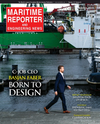
Page 59: of Maritime Reporter Magazine (October 2019)
Marine Design Annual
Read this page in Pdf, Flash or Html5 edition of October 2019 Maritime Reporter Magazine
T
THOUGHT LEADERSHIP CLASSIFICATION ergy for international shipping in mid- potential to shape the fuel mix. They insights for maritime stakeholders. The ers on this journey. But with ? exibility century if IMO GHG ambitions are to be trade large volumes on ? xed routes – of- transition to a lower carbon future will and perseverance, we believe shipping achieved. For all pathways, shore-based fering suppliers reliable fuel demand. be a great challenge for the industry, but can meet this challenge and continue to electricity provides about 5%–7% of to- But most operators will have to be more we are committed to supporting custom- thrive in the years ahead.
tal energy for shipping in 2050 through ? exible in their fuel choice. batteries and shore-to-ship power. The In the transition phase, investing in service and passenger segments have the fuel ? exibility and bridging technologies highest share, almost 18% of their en- is a good way to prepare for a low carbon ergy being provided by grid electricity. future. In deep sea segments, dual-fuel
We have lower and potentially carbon combustion engines and alternative fuel neutral options in use today, with LNG, ready solutions could help reduce fu- electric, biofuels, and biofuels for exam- ture retro? t costs. In addition, bridging ple. But in the context of ship fuel, what technologies such as fuel-? exible energy does it mean to be carbon neutral? This converters, fuel storage tanks, onboard is an important concept for the industry systems and shore-side fuel infrastruc- to meet the 2050 goal ture can help ease the transition from
The term carbon-neutral refers to a traditional to carbon neutral fuels.
variety of energy sources or energy sys- At DNV GL we are working with our tems that have no net GHG emissions, customers to help facilitate the transition or carbon footprint. Either a fuel can be towards a low carbon future. By devel- ‘naturally’ carbon free. This is the case oping and updating our rules and stan- for electricity, hydrogen and ammonia, dards to ensure safety, researching new if produced from renewable energy or technologies and ef? ciency measures, fossil energy with carbon capture, for and offering tools and information to as- example. Or, the fuel can contain some sess new fuels and technologies we hope carbon, but the carbon is sustainably to build a basis for the industry in this sourced and part of the natural carbon new future. The Maritime Forecast is a cycle. This category includes sustainably part of this, providing guidance, high- produced biodiesel and liquid biogas and lighting trends, and offering valuable carbon based electrofuels. Electrofuels is the term for synthetic fuels like die- sel, methane and methanol, when they are produced from hydrogen and CO2 (carbon based) or from hydrogen and nitrogen (nitrogen-based fuels such as ammonia), using renewable electricity to power the production.
Making this transition presents many challenges, especially in the deep-sea segment, where a decision to back a new fuel requires a massive investment. For example, without any infrastructure and distribution, it is dif? cult for shipowners to commit to a new fuel. But suppliers will not develop the infrastructure before they are certain of demand. Being forced to pick a winner among many options, is a risk that can be a barrier to adoption.
Here, short sea shipping can be an im- portant test ground for new fuels and a valuable stepping stone for getting both technology and infrastructure ready for bigger deep-sea vessels.
Because, without the required infra- structure and distribution, it is dif? cult for shipowners to commit to a new fuel.
Suppliers will not develop the infrastruc- ture before they are certain of demand.
However, big liner companies have the www.marinelink.com 59
MR #10 (59-65).indd 59 10/7/2019 3:13:27 PM

 58
58

 60
60
